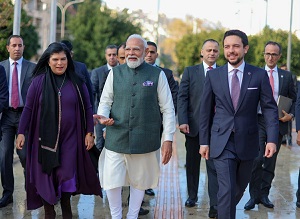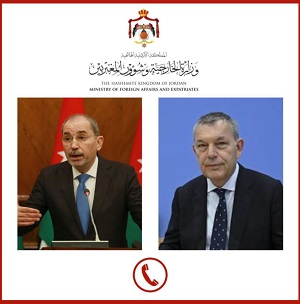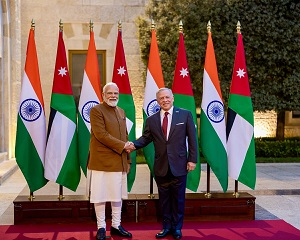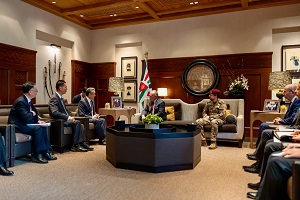‘London Bridge is down’ - By Imran Khalid, The Jordan Times
“London Bridge is down” is how Sir Edward Young, Queen’s private secretary, conveyed the official news about the death of Queen Elizabeth II to Prime Minister Liz Truss on Thursday on the phone as per the royal protocol. With this, the reign of the longest serving sovereign of the English monarchy’s 1,000-year history has come to a somber end.
This Tuesday, during her last royal ritual as the British monarch by having traditional audience with incoming Prime Minister Liz Truss, she appeared very weak in the images released by the Buckingham Palace.
Despite being constitutional monarch and a product of ancestral inheritance, Queen Elizabeth was certainly more popular globally than any other politician or head of state. The revered monarch, the only one most people in the United Kingdom have ever known, was a symbol of stability and continuity of Britain’s imperial family.
“I declare before you all that my whole life whether it be long or short, shall be devoted to your service and the service of our great imperial family to which we all belong,” said Princess Elizabeth in a radio broadcast on her 21st birthday in 1947. And she stuck to this pledge till her last breath. Just five years after this historic broadcast, upon the death of her father King George VI, she was ascended to the throne as a queen. But few had anticipated in 1952 how much drastically she would transform the institution of monarchy due to her own persona. In fact, this transformation started from the day of her coronation. Unlike her father, who was crowned as King George VI of Great Britain, Ireland and the British Dominions beyond the Seas, Defender of the Faith and Emperor of India,” she was proclaimed Queen Elizabeth II, “Queen of this Realm and of all Her other Realms and Territories, Head of the Commonwealth, Defender of the Faith.”
Change of Queen’s title was the starting point of emergence of two queens: global queen and national queen. Throughout her 70 year long reign, Queen Elizabeth remained visibly divided into two perception blocs.
Imperial retreat, which also coincided with the shrinkage of the British Empire, was imbedded in this title change. Britain had been incorporated into a multinational configuration that it no longer led. In Britain, Elizabeth would be “Queen of the United Kingdom,” but elsewhere she would be given different titles, granted by different countries: Queen of Australia and Queen of Canada etc. by the time Queen Elizabeth crowned, the British Empire was no more a single empire with a single sovereign.
Queen Elizabeth had already sensed the emerging thinking patterns of the British Commonwealth and she did a wonderful job in adjusting herself and her institution with the new realities. Great Britain was on the path of shrinkage, and she knew it well that she could only retain the British Commonwealth intact by projecting herself more as global queen — or queen of the commonwealth — rather than national queen of Britain. In her first royal tour of the Commonwealth, in 1953–54, she toured 13 countries, including Bermuda, Jamaica, Sri Lanka, Australia, and New Zealand, covering more than 40,000 miles in six months. During her historic visit to Australia, almost seven million people turned out to see her, which was 75 percent of the country’s population at that time.
However, the bitter realities of the post-imperial world, which was witnessing astounding shift in the status of Great Britain from the biggest empire on the planet to a shrunken country that was desperate for the patronage of the United States to remain relevant in the global power fabric, greatly impacted the thoughts of Queen Elizabeth. It was not easy for the Britons to gulp down the bitter pill that they were once again an island people. Only Queen Elizabeth was global.
Queen Elizabeth readily accepted the reality that she had to be Britain Queen as well as Global Queen simultaneously. Though in this effort of playing the double-role, she had been subjected to severe criticism at home, particularly far right nationalists, but she never retracted her stance. She actually traded greater British — and her personal — influence with the loss of empire. A staunch supporter of recognition of African nationalism, in 1960, she wholeheartedly supported the then British Prime Minister Harold Macmillan’s plan of decolonisation of Africa. She deserves a huge credit along with Macmillan for the fast-track process of decolonization in East, West, and Central Africa.
By the mid-1960s, as the empire continued to melt away swiftly, there was a very real prospect of resistance from the nationalists and royalists. There was an underlying hazard in creating the romantic fiction of the British Commonwealth; the Queen could lose the support of her people at home by appearing to have split loyalties. The imperial monarchy, Queen’s much-adored notion, appeared to be threatening the national monarchy. In true sense, these tensions really began to emerge on the surface when Margaret Thatcher assumed the control of the Conservative Party as its leader. Ms. Thatcher had never been enthusiastic about the Commonwealth at all, and she was less sympathiser for the policies of some of more radical members of her party.
In his book “Monarchy and the End of Empire”, Philip Murphy has written that Thatcher and her closest advisers joked that the acronym CHOGM — for the Commonwealth Heads of Government Meeting —stood for “Compulsory Hand-Outs for Greedy Mendicants.” The Thatcherite narrative, which was completely enveloped by the cold war mentality, was seriously disliked by Queen Elizabeth. The relations between the two touched the lowest ebb when in 1986 many countries threatened to boycott the Commonwealth Games in protest of Thatcher’s opposition to sanctions against apartheid South Africa. Britain had been almost isolated on this issue, with the Queen conspicuously avoiding taking Britain’s side. The fact is that Queen’s personal intervention actually saved the whole event.
Queen Elizabeth had assumed the role of a flag-bearer of global multiculturalism at home and abroad – and, by that account, she turned into a modern monarch. She stands taller than all British monarchs, but on the other hand, she was the one who “facilitated” the massive contraction of monarch’s power, prestige and influence. It is also a fact that generations have seen nothing but the Queen. There is no comparable public personality who will have been mourned as deeply in Britain and whose death could incite a greater reckoning with the identity and future of the country. An air of permanence surrounded her persona due to the extraordinary longevity of her stint.
During her seven-decade reign, Queen Elizabeth has seen many ups and downs. Idiosyncrasies of her family were endless. From the abdication of her uncle, Edward, to marry his American lover, Wallis Simpson, which actually sculpted the course of events that put her on the throne, to the excruciating fissure between her grandson, Prince Harry, and the rest of the royal family after his marriage to Meghan Markle, she had to endure a lot of unsavoury and painful episodes. She played the true anchoring role in keeping the House of Windsor stable despite unabating series of cataclysms and upheavals. With the exception of her misstep in 1997, when she secluded herself for days at Balmoral Castle in Scotland in an attempt to evade the nation’s mourning over Princess Diana’s unfortunate death in road accident, Queen Elizabeth had always displayed dignity, grace and sense of duty that put her in the pantheon of royal greats.
She was perhaps the most experienced head of state until the time of her death. In her long reign, she interacted with 13 out of 14 US presidents and worked with 15 British prime ministers. After the Queen’s departure, the British monarchy is likely to face further erosion of its influence and charisma, not only at home, but also in the global arena. However, still it depends upon King Charles and how he carries himself and aligns his thinking with the evolving relationship between the monarchy and the British.
The writer is a freelance columnist for international affairs, based in Karachi, Pakistan




